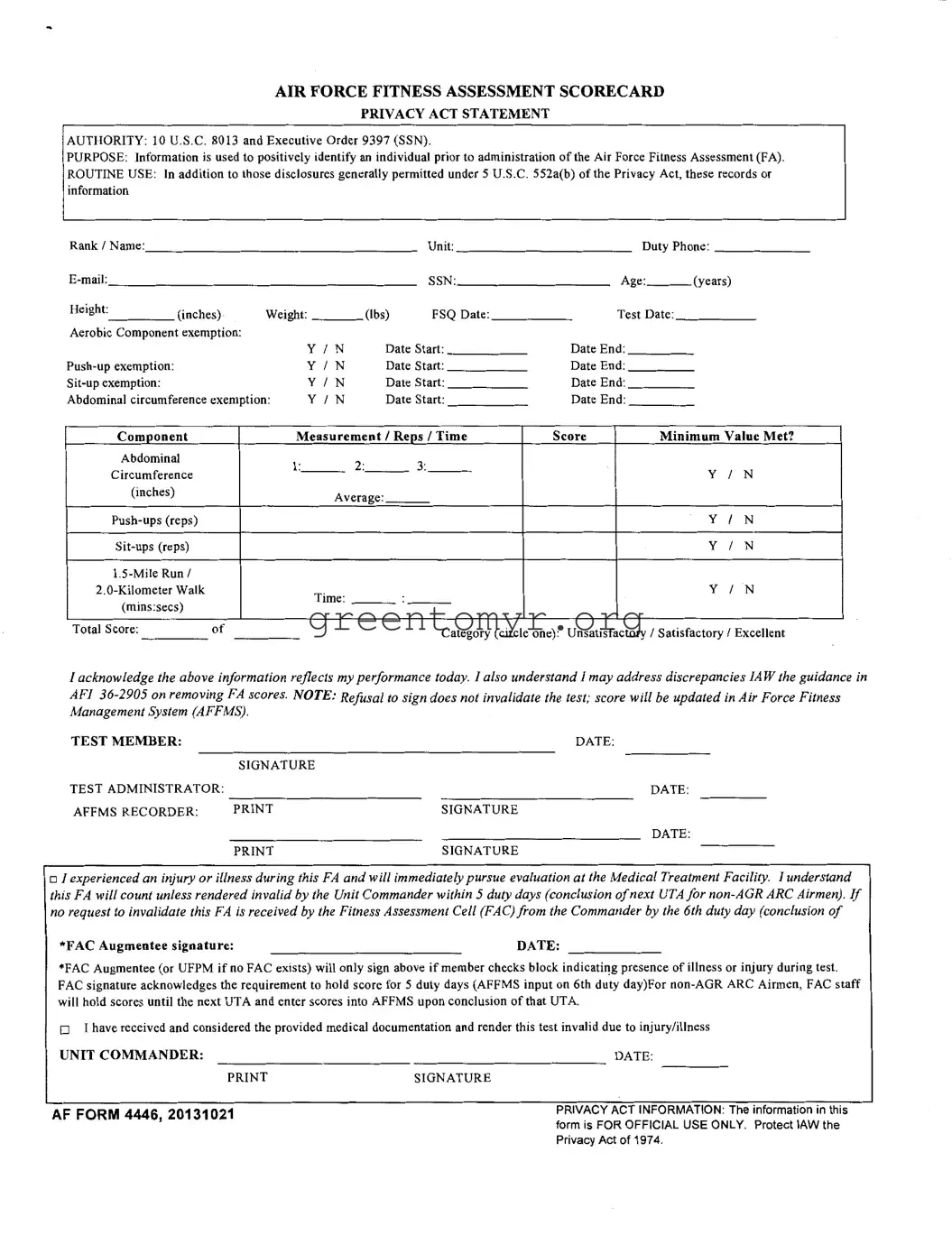AIR FORCE FITNESS ASSESSMENT SCORECARD
PRIVACY ACT STATEMENT
AUTHORITY: 10 U.S.C. 8013 and Executive Order 9397 (SSN).
PURPOSE: Information is used to positively identify an individual prior to administration of the Air Force Fitness Assessment (FA).
ROUTINE USE: In addition to those disclosures generally permitted under 5 U.S.C. 552a(b) of the Privacy Act, these records or information
Rank/Name:._________________________________ |
Unit: -------------------- |
Duty Phone: __________ |
|
|
|
|
|
|
|
|
|
|
|
|
|
|
|
E-mail: ____________________________________ SSN: _________ |
Age: ___ (years) |
|
|
|
|
|
|
|
|
|
|
Height:____ (inches) |
Weight: ___ (lbs) |
FSQ Date: _____ |
Test Date: _____ |
Aerobic Component exemption: |
|
|
|
|
|
|
|
|
|
|
|
|
|
YIN |
Date Start: ______ |
Date End: _____ |
|
|
Push-up exemption: |
|
|
YIN |
Date Start: _____ |
Date End: _____ |
|
|
Sit-up exemption: |
|
|
YIN |
Date Start: ______ |
Date End: _____ |
|
|
Abdominal circumference exemption: |
YIN |
Date Start: ______ |
Date End: ______ |
|
|
Component |
|
|
Measurement I Reps I Time |
Score |
|
Minimum Value Met? |
Abdominal |
|
|
1:______ |
2:--- 3: --- |
|
|
|
|
|
|
|
|
|
|
|
y |
I |
|
Circumference |
|
|
|
|
|
N |
(inches) |
|
|
Average: |
|
|
|
|
|
|
|
|
|
|
|
|
|
|
|
|
Push-ups (reps) |
|
|
|
|
|
|
|
y |
I |
N |
Sit-ups (reps) |
|
|
|
|
|
|
|
y |
I |
N |
1.5-Mile Run I |
|
|
|
|
|
|
|
|
|
|
2.0-Kilometer Walk |
|
|
Time: |
--- · --- |
|
|
y |
I |
N |
(mins:secs) |
|
|
|
|
|
|
|
|
|
|
|
|
|
|
|
|
|
Total Score: |
----- |
of |
|
|
|
Category (circle one): Unsatisfactory I Satisfactory I Excellent |
|
|
|
|
|
|
|
|
|
|
|
|
|
|
|
|
I acknowledge the above information reflects my performance today. I also understand I may address discrepancies !A W the guidance in
AFI 36-2905 on removing FA scores. NOTE: Refusal to sign does not invalidate the test; score will be updated in Air Force Fitness Management System (AFFMS).
TEST MEMBER: |
|
DATE: |
|
SIGNATURE |
|
TEST ADMINISTRATOR: ------------------------ |
DATE: |
AFFMS RECORDER: |
PRINT |
SIGNATURE |
|
|
DATE: |
|
PRINT |
SIGNATURE |
o I experienced an injury or illness during this FA and will immediately pursue evaluation at the Medical Treatment Facility. I understand this FA will count unless rendered invalid by the Unit Commander within 5 duty days (conclusion ofnext UTA for non-AGR ARC Airmen).lf no request to invalidate this FA is received by the Fitness Assessment Cell (FAC) from the Commander by the 6th duty day (conclusion of
*FAC Augmentee signature: |
DATE: |
*FAC Augmentee (or UFPM if no FAC exists) will only sign above if member checks block indicating presence of illness or injury during test. FAC signature acknowledges the requirement to hold score for 5 duty days (AFFMS input on 6th duty day)For non-AGR ARC Airmen, FAC staff will hold scores until the next UTA and enter scores into AFFMS upon conclusion of that UTA.
o I have received and considered the provided medical documentation and render this test invalid due to injury/illness
|
UNIT COMMANDER: |
DATE: ----- |
|
PRINT |
SIGNATURE |
|
AF FORM 4446, 20131021 |
PRIVACY ACT INFORMATION: The information in this |
|
form is FOR OFFICIAL USE ONLY. Protect lAW the |
|
|
|
|
Privacy Act of 1974. |

